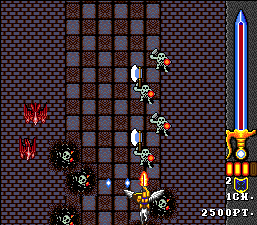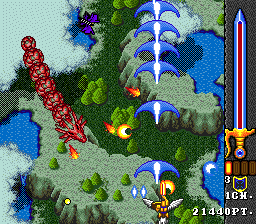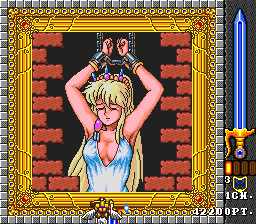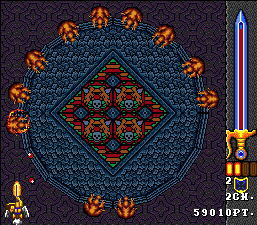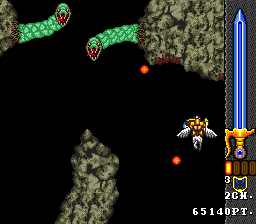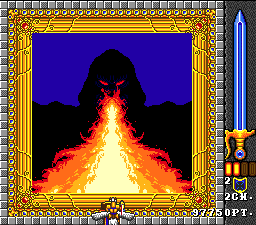Main
What's
New
Import Stores
Import Reviews
Import Cover Archive
Special Features
Games
The Top
100
Video Game Fiction
Wanted!
Acknowledgements
Forum
Links
Import Stores
Import Reviews
Import Cover Archive
Special Features
Games
The Top 100
Video Game Fiction
Wanted!
Acknowledgements
Forum
Links
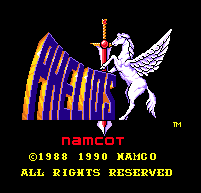
Namco released the game Phelios in arcades sometime in 1988, then later on the Sega Mega Drive/Genesis in 1990. It was an overhead shooter wrapped in the cloak of Greek mythology that used elements from both Gradius and R-Type during gameplay. The Genesis version was met with favorable reviews, and was a moderate hit for Namco. After a year or so, though, Phelios was forgotten in favor of newer games (along with the other game Namco released at the same time, Burning Force). Still, most shmup fans recall it is one of the better overhead shooters on the Genesis.
The story behind Phelios was not only based on Greek mythology, it also used one of the most overdone themes ever used in a game: rescue the princess from evil. In this case, the princess is Artemis, goddess of the moon and the evil is Typhon, one of the Titans (specifically, the one that Zeus dropped a mountain on). You play the heroic Apollo, god of the sun, and you must ride the legendary winged horse Pegasus to rescue Artemis. Along the way, you have to defeat various mythological creatures, such as Medusa (who is probably the Greek character most overused in video games), Antaeus, Scylla and Cerberus. To my knowledge, almost none of these characters ever interacted in the myths, which is why I say that the game was based on Greek mythology.
One of the more interesting things about Phelios were the cinema scenes that appeared after each level. They served to advance the story (I particularly loved the part where Typhon mocks Artemis' cries for help), and they also show Artemis being stripped and tortured, Rolling Thunder-style. Now before you start thinking that this is what I'm talking about when I mention Phelios' dark secret, let me just say that it's not. Artemis only gets stripped to her underwear, and the only torture you see is Artemis being lowered into Typhon's flames. Not a big deal.
During one of those scenes, Artemis lets Apollo know that she "still remembers those days", and she then flashes back to a lovely picture of the two of them together, holding hands and kissing. At the end of the game, she gives you a message that has a lipstick print on it and the words "Loving you". Then the two of them fly off to Olympus together. Now, I'm not sure how familiar you are with Greek mythology, but here's the kicker - in the myths, Apollo and Artemis are brother and sister.
Makes you sick just thinking about it, eh?
Now some people would just chalk this up to the guys at Namco not knowing any better. After all, they're Japanese. How much time did they put into making sure their story (based on an ancient myth from another culture entirely) was accurate? The thing is, if you go back and read a lot of the myths, the idea of Apollo and Artemis being both brother and sister and lovers at the same time isn't farfetched. Those Greek gods were a freaky, twisted bunch - in fact, the term "sexually deviant" might be considered an understatement when talking about them. The king of the gods, Zeus himself, married Hera, who was actually his sister. He was banging her and everything else he could get his hands on - women, young girls, boys, animals, you name it. Sick. And that's just one of many examples.
Of course, to the average person playing Phelios, you're just some guy on a flying horse trying to save a hot blonde from a demon. But to those of us that know the truth, we just have to shake our heads and keep playing. After all, Phelios is still a good game, and one well worth playing. Just do yourself a favor and don't think about what's happening behind the scenes.
Screenshots (Sega Genesis version):
